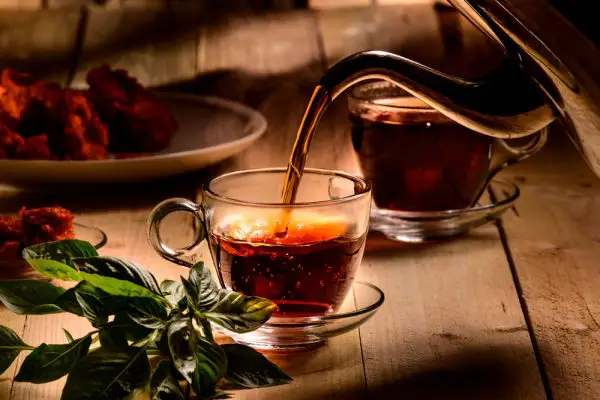Black tea, which is perhaps one of the best known types of tea, is made from the leaves of the Camellia sinensis plant. Named after the color of the dry leaves, this tea is also referred to as “red tea” in China.
What makes this type of tea unique is the oxidation of the tea leaves. All authentic tea is made from the leaves of one plant. Where some tea leaves are unoxidized or only partially dried, black tea leaves are fully oxidized. By allowing the leaves to be exposed to the air and to dry completely, darker leaves and a stronger, more aromatic tea results. Black tea leaves also get better with age; the longer they can sit, the better the brewed tea will taste.
Origins & Growth
While the Camellia sinensis plant is grown in many countries including India and Sri Lanka, black tea’s roots can be traced back to 17th century China. There is a popular legend that surrounds black tea and how it came to be.
The Legend Behind Black Tea
As the tale goes, traveling soldiers entered the southeastern Chinese province of Fujian and stopped to rest near a tea factory. Their presence halted tea production, abandoning the tea leaves outside in the hot sun. This led to the oxidation and darkening of the tea leaves.
Since this was unavoidable, the people decided to dry the leaves the rest of the way by smoking them. These leaves were later used to make tea. The stronger, darker, and bolder flavor that resulted, although an accident at the time, came to be known as black tea.
Making Black Tea
The type of black tea you purchase determines the brewing process. After all, there is a big difference between having whole loose leaves and having dustings in a tea bag.
In order to make a delicious cup of loose-leaf tea, you will need a pot to boil water, a tea kettle with a lid for steeping the tea leaves, a vessel (or tea cup) to enjoy the tea when it is ready, and a tea strainer. In order to brew the tastiest cup of black tea, the following steps should be taken:
- Bring water to a rolling boil. For the best results, it is suggested to use spring water.
- Pre-heat your vessel and tea kettle with some of the boiling water. Allow the hot water to sit in both items just long enough to heat them up. Then, discard the water.
- Place the measured-out portion of tea leaves into the pre-heated tea kettle. (It is recommended that 1 tsp of loose-leaf tea is used for every 8-10 oz of water that will be poured into the tea kettle.)
- Pour the correct amount of boiling water into the tea kettle, right on top of the tea leaves.
- Steep the tea leaves for three to five minutes, with the tea kettle cover on.
- When the time is up, strain the tea into your vessel and enjoy.
Variations & Flavors
India is the top producer of black tea in today’s market. In fact, half of the tea produced comes from India. Sri Lanka and Bangladesh also produce popular varieties of black tea. In most cases, the variety of black tea is named after the area or region where it was produced.
Like the name, the taste of black tea is also directly related to the area where the plant is grown. Many black tea beverages also have additives like milk to enhance the flavor. Some tasty blends include:
- Assam Black Tea- produced in India, this tea has a rich aftertaste with subtle notes of chocolate
- Earl Grey- this type of tea is often infused with Bergamot oil (a citrus mixture of bitter orange and lemon) and vanilla
- Kenyan Black Tea-this bold tea has delectable notes of citrus, anise, cardamom, and chocolate
- Ceylon Black Tea- produced in Sri Lanka, this tea is strong and rich with citrus flavor and small chocolate undertones
- Darjeeling Black Tea- produced in India, the tea has a distinct and unique sweet spiciness (often referred to as a “muscatel flavor”)
Black Tea in America
Ever had an ice-cold cup of iced tea on a hot summer day? Chances are that iced tea was made with black tea. In fact, nearly 85% of tea enjoyed in America is cold and/or with ice.
Appearance
Black tea leaves, due to the oxidation process, are very dark. On the other hand, the tea that is brewed with them has a rich red appearance.
Nutritional Values
One serving of black tea (8 oz) has a relatively low nutritional value. With just 2 calories per serving, there are zero fats, less than one gram of carbs, and zero grams of protein. As far as caffeine content, one 8 oz glass of black tea contains 47 g of caffeine.
Shelf Life
Since Black tea is fully oxidized, it has a longer shelf life than that of other teas. If stored properly in either tins or foil bags to help keep moisture at bay, this type of tea can keep its sensational aroma and rich taste for up to three years.
“Spill the Tea” on Black Tea
Globally, tea is the second most enjoyed beverage and black tea is one of the most popular varieties. With each type of tea being brewed from the same plant, Camellia sinensis, the only difference between them is oxidation process, or lack thereof, that takes place with the leaves.
While some tea leaves are left unoxidized, black tea is fully oxidized. This gives the leaves their dark appearance and the tea its bold flavor. While this type of tea is produced in many countries, it originated in China. Since various places can grow, harvest, and produce tea, the flavor of the tea is also unique to each geographic location.
Next time you reach for thirst quenching iced tea, you could be experiencing the beauty of black tea.

